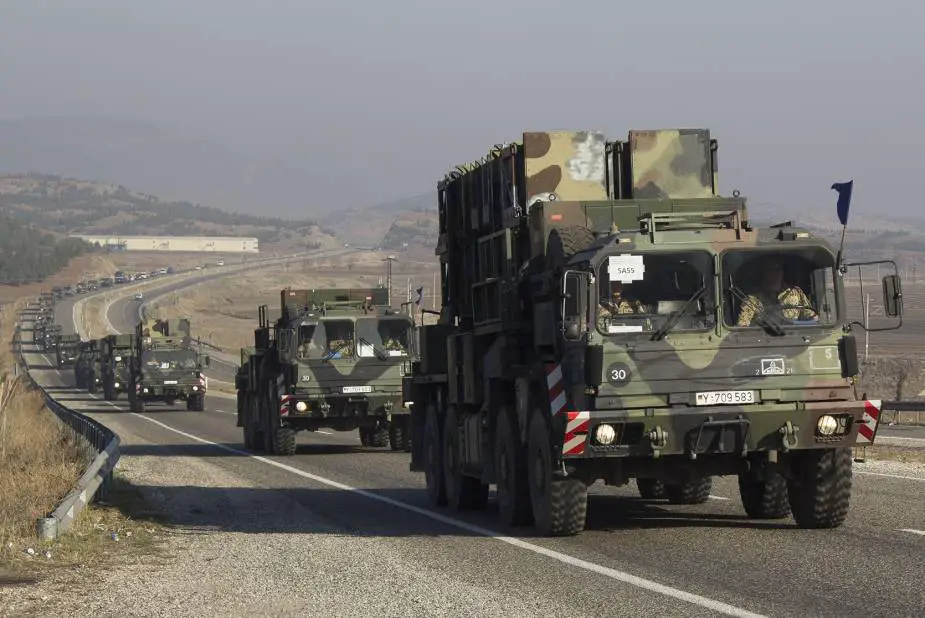Breaking news
European Union proposes actions to allow armed forces to move faster and better across borders.
On November 10, the European Commission and the High Representative put forward an Action Plan on Military Mobility 2.0 and a Joint Communication on an EU cyber defence policy to address the deteriorating security environment following Russia’s aggression against Ukraine and to boost the EU’s capacity to protect its citizens and infrastructure.
Follow Army Recognition on Google News at this link

The Action Plan on Military Mobility will help European armed forces to respond better, more rapidly and at a sufficient scale to crises erupting at the EU’s external borders and beyond (Picture source: EDA/Bundeswehr)
In particular, the Action Plan on Military Mobility will help European armed forces to respond better, more rapidly and at a sufficient scale to crises erupting at the EU’s external borders and beyond. It will bolster the EU’s ability to support Member States and partners as regards the transport of troops and their equipment. It works towards better connected and protected infrastructure while streamlining regulatory issues. It will reinforce cooperation with NATO and promote connectivity and dialogue with key partners.
Building on the achievements of the first Action Plan launched in 2018, the new Military Mobility covers the period 2022-2026 and includes:
• Identification of possible gaps in the infrastructure, informing future actions to prioritise improvements and integrate fuel supply chain requirements, to support short-notice large-scale movements of military forces;
• Digitalisation of administrative processes related to customs logistics and military mobility systems;
• Measures to protect transport infrastructure from cyber-attacks and other hybrid threats;
• Development of military strategic lift capabilities to enhance the mobility of the armed forces by air and sea;
• Enhancing the energy efficiency and climate resilience of transport systems;
• Reinforcing cooperation with NATO and key strategic partners, such as the US, Canada and Norway, while promoting connectivity and dialogue with regional partners and enlargement countries, such as Ukraine, Moldova and the Western Balkans.
To ensure a well-connected, capable and secure military mobility network, the European Commission is supporting the Action Plan with funding instruments such as the Connecting Europe Facility (funding dual-use transport infrastructure projects), and the European Defence Fund (supporting the development of interoperable logistical and digital systems).
Background
The first Action Plan on Military Mobility was launched in 2018 to strengthen the EU Common Security and Defence Policy. It aimed to ensure swift and seamless movement of military personnel, materiel and assets – including at short notice and at large scale – within and beyond the EU. It helped to create a well-connected network, with shorter reaction times and capable, secure and resilient transport infrastructure and capabilities. The new Action Plan on Military Mobility responds to the call in the Strategic Compass to enhance the military mobility of our armed forces within and beyond the Union following Russia’s military aggression against Ukraine. This urgent need was also reflected in the Joint Communication on defence investment gaps adopted in June 2022.
Military Mobility is supported through other defence initiatives, notably through the Permanent Structured Cooperation (PESCO) Military Mobility project and Logistical Hubs project. The European Defence Agency’s programme on “Optimising Cross-Border Movement Permission procedures in Europe” and the Coordinated Annual Review on Defence (CARD) also contribute to the effort.
Together with the Security and Defence package, the Commission is also publishing today the first progress report on the Action Plan on synergies between civil, defence, and space industries, available here.
Executive Vice-President Margrethe Vestager said: “With these two initiatives the Commission is today stepping up its contribution to Europe’s defence. We have to be more attentive and aware of the defence dimension of our infrastructure and networks, and today we lay out how the EU’s instruments and policies can make the difference in ensuring we are better prepared and able to react better to external threats.”
High Representative and Vice President Josep Borrell said: “One of the main lessons from the delivery of weapons and military equipment to Ukraine to fight Russia’s invasion is that every second matters. Fast military mobility is crucial to respond to crises emerging at our borders and beyond. Much has been done to date, but the Strategic Compass has set higher ambitions and we are delivering. With this new Action Plan on Military Mobility, we will address existing bottlenecks to allow for swift and efficient movements of our armed forces. We will ensure that our armed forces have access to strategic lift capabilities and that infrastructure is better protected from cyber and other hybrid threats. And we will do this with our partners, including NATO.”
Commissioner for Internal Market Thierry Breton said: “The crisis in Ukraine has shown the vital importance of ensuring swift military assistance. The Action Plan on Military Mobility 2.0 will strongly contribute to the ability of our Armed Forces to quickly respond to crises at the EU’s external borders and beyond. With a budget of 9 million Euro under the European Defence Fund, we are co-funding a consortium of companies from nine EU Member States plus Norway for the development of a digital system for a quick and secure information exchange related to Military Mobility. We will continue to work on the digitalization of administrative processes, under the European Defence Fund, to substantially enhance Military Mobility.”
Commissioner for Transport Adina Vălean said: “Russia’s military aggression against Ukraine has confirmed that we need to continue improving the capacity of transport infrastructure, such as roads, bridges, and rail tracks, allowing our armed forces and their equipment to move around the EU with ease. With a budget of 1.69 billion euros for 2021-2027, we are already co-funding dual-use transport infrastructure projects through our Connecting Europe Facility. Under the new Action Plan, we will assess the extent to which today’s physical transport infrastructure meets military requirements, and what the current gaps are. The findings will help us to prioritise infrastructure for development, and allocate funding at the EU level appropriately.”


























